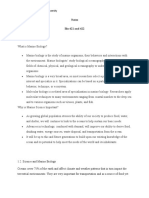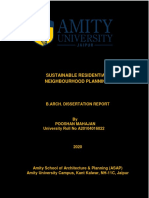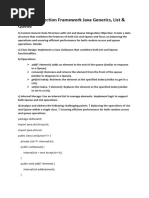0 ratings0% found this document useful (0 votes)
CO2
CO2
Uploaded by
Anh Đặng HoàngThe research conducted by Christopher Hamilton and his team at the underwater laboratory "Silver Whale" shed new light on ocean acidification and its effects on coral reefs. They discovered that carbon dioxide produced by sponges and other organisms was acidifying not only the reef but also the adjacent sand. Experiments also revealed that the thin layer of water above the sediment was being acidified by sponge-generated carbon dioxide at a rate that could explain declining coral reefs worldwide. If this top living layer of coral does not recover, the reefs will eventually disintegrate, disrupting the food chain and causing the loss of many reef-dwelling species.
Copyright:
© All Rights Reserved
Available Formats
Download as DOCX, PDF, TXT or read online from Scribd
Download as docx, pdf, or txt
CO2
CO2
Uploaded by
Anh Đặng Hoàng0 ratings0% found this document useful (0 votes)
The research conducted by Christopher Hamilton and his team at the underwater laboratory "Silver Whale" shed new light on ocean acidification and its effects on coral reefs. They discovered that carbon dioxide produced by sponges and other organisms was acidifying not only the reef but also the adjacent sand. Experiments also revealed that the thin layer of water above the sediment was being acidified by sponge-generated carbon dioxide at a rate that could explain declining coral reefs worldwide. If this top living layer of coral does not recover, the reefs will eventually disintegrate, disrupting the food chain and causing the loss of many reef-dwelling species.
Copyright
© © All Rights Reserved
Available Formats
DOCX, PDF, TXT or read online from Scribd
Share this document
Did you find this document useful?
Is this content inappropriate?
The research conducted by Christopher Hamilton and his team at the underwater laboratory "Silver Whale" shed new light on ocean acidification and its effects on coral reefs. They discovered that carbon dioxide produced by sponges and other organisms was acidifying not only the reef but also the adjacent sand. Experiments also revealed that the thin layer of water above the sediment was being acidified by sponge-generated carbon dioxide at a rate that could explain declining coral reefs worldwide. If this top living layer of coral does not recover, the reefs will eventually disintegrate, disrupting the food chain and causing the loss of many reef-dwelling species.
Copyright:
© All Rights Reserved
Available Formats
Download as DOCX, PDF, TXT or read online from Scribd
Download as docx, pdf, or txt
0 ratings0% found this document useful (0 votes)
CO2
CO2
Uploaded by
Anh Đặng HoàngThe research conducted by Christopher Hamilton and his team at the underwater laboratory "Silver Whale" shed new light on ocean acidification and its effects on coral reefs. They discovered that carbon dioxide produced by sponges and other organisms was acidifying not only the reef but also the adjacent sand. Experiments also revealed that the thin layer of water above the sediment was being acidified by sponge-generated carbon dioxide at a rate that could explain declining coral reefs worldwide. If this top living layer of coral does not recover, the reefs will eventually disintegrate, disrupting the food chain and causing the loss of many reef-dwelling species.
Copyright:
© All Rights Reserved
Available Formats
Download as DOCX, PDF, TXT or read online from Scribd
Download as docx, pdf, or txt
You are on page 1/ 4
A
Oceanic acidification is the most recent phenomenon to endanger coral reefs.
Research conducted by the Florida Aquatic Life Organisation (FALCO) is
shedding new light on why and how extreme acidity levels occur and the
consequent effects on life forms which inhabit these reefs Christopher Hamilton,
chief researcher on the project, spent the majority of 2010 submerged beneath the
ocean in the world's only fully functioning underwater laboratory. Constructed
from a revolutionary alloy and resembling a holiday caravan in appearance, the 15-
metre long “Silver Whale' housed a laboratory and testing facilities for its three
rotating occupants, all leading experts in marine biology. The project was the
culmination of almost a decade of planning and represented an unrivalled
opportunity to collate primary data regarding the effects of acidity levels in waters
surrounding a reef.
В
The research study confirmed the beliefs of Hamilton and other marine biologists:
that general increments in acidity pH levels during nighttime hours and the
opposite decrease during the daytime are a natural occurrence. Photosynthesizing
algae absorb the vast majority of daytime carbon dioxide (CO2) produced through
the respiration of animals and microorganisms. Thus, in the evening and at night
this equilibrium is removed and CO2 and acidity levels increase. What Hamilton
and his team found more startling were several unexpected discoveries which may
prove more significant for the marine biology community at large. The first
discovery confirmed the suspicions of countless academics and environmentalists:
Hamilton's crew recorded noteworthy pH changes in test samples not only from the
reef but also the adjacent sand. Assistant researcher and marine biology student
Sarah Brown comments that 'this is a startling discovery and clearly demonstrates
the escalating impact CO2 is having upon the marine environment'. Hamilton
attributes this development to the CO2 production capacity of sponge organisms
which inhabit the reel and the surrounding area. Although these latest experiments
did not include these creatures within their spectrum of test subjects, previous
studies carried out by Hamilton and his colleagues in 2004 measured sponge
water-pumping rates of up to an impressive 100,000 times their body volume per
day. This substantial CO2 production is further exacerbated by other parasitic
microorganisms housed within these sponges.
C
Experiments centred on dye-release within the reef revealed a thin layer of water
directly above the sediment showing clearly that the reef does not, as other
scientists claimed, integrate itself for prolonged periods with the overlying water.
Therefore, tentative report findings suggest that sponge and organism-generated
CO2 may be diffusing at a sufficient rate to acidify the water. According to
Hamilton, 'if this is true then it could provide one explanation for the continual
decrease in worldwide coral reefs.' Acidification of this layer caused by escalating
sponge generation appears to be a logical conclusion when their astonishing levels
of CO2 capability are taken into consideration. Without rigorously tested scientific
evidence, Hamilton's assertion remains open to scepticism yet his report implies
that this minute water layer may actually be the key to finally understanding
oceanic acidification warning that 'If this top living layer of coral does not reassert
itself, then the reefs will eventually disintegrate.'
D
Augmented levels of acid will undoubtedly continue to exacerbate the plight of the
coral reefs and their inhabiting organisms. Reefs are home to a large variety of
organisms, such as molluscs, crustaceans and echinoderms. A considerable
proportion of these feed directly on coral, while others graze on algae which reside
on the reef. In addition, there is the wealth of fish and even mammals living around
the coral reefs that rely upon these life forms as a source of sustenance. For
thousands of years there has been a natural equilibrium and so the depletion of the
reefs as a viable food source for smaller creatures will have a subsequent effect
throughout the food cycle. One of the findings in Hamilton's research - which he
attributes to reef depletion - details the plummeting range of marine life already
around his test area in comparison to previous studies 20 years ago. According to
the report a 23 percent drop was noted in the amount of local fish alone and he
cites statistically rigorous evidence to support his conclusion that these figures are
not just incidental, they are caused by receding reefs.' Rising acidification levels
cause the polyps in the reef to be eaten away by predators, devastated by disease,
or simply become so stressed that they die. The resulting destruction of a viable
food source will cause the creatures which dwell on the reefs to vanish from the
area and eventually become extinct. General consensus around the world is that
coral reefs are receding at an alarmingly rapid rate but because reef habitats are
exceptionally complex and worldwide reef monitoring and mapping efforts only
began in the late 1990s, scientists simply lack sufficient information to keep track
of their destruction. Unfortunately, at this rate they may soon be beyond repair.
The Global Coral Reef Monitoring Network (GCRMN), the largest coral reef
monitoring organisation in the world, reported at the 15th International Coral Reef
Symposium that 42 percent have already been lost and at least another 40 percent
could disappear within the next 20 years. Hamilton is convinced his research
laboratory has a unique role to play in addressing this issue and welcomes
international experts in the hope that they will set up their own similar aqua
observatory laboratories.
You might also like
- Tropical Dead Zones and Mass Mortalities On Coral ReefsNo ratings yetTropical Dead Zones and Mass Mortalities On Coral Reefs10 pages
- Marine Pollution and Prevention: Nwaogwugwu Tochukwu CollinsNo ratings yetMarine Pollution and Prevention: Nwaogwugwu Tochukwu Collins3 pages
- Cold Water Deep Sea Corals:: A New Frontier of DiscoveryNo ratings yetCold Water Deep Sea Corals:: A New Frontier of Discovery12 pages
- Ocean Acidification Impacts On BangladeshNo ratings yetOcean Acidification Impacts On Bangladesh3 pages
- CURRENT GLOBAL CHALLENGES IN THE OCEANS AND SEASNo ratings yetCURRENT GLOBAL CHALLENGES IN THE OCEANS AND SEAS6 pages
- Levels of Toxic PCB Chemicals Found at 30 Times Safe' Limits inNo ratings yetLevels of Toxic PCB Chemicals Found at 30 Times Safe' Limits in4 pages
- NOAA-led Researchers Discover Ocean Acidity Is Dissolving Shells of Tiny Snails Off The U.S. West CoNo ratings yetNOAA-led Researchers Discover Ocean Acidity Is Dissolving Shells of Tiny Snails Off The U.S. West Co5 pages
- Webapge - Environmental, Scientific, TechnologicalNo ratings yetWebapge - Environmental, Scientific, Technological2 pages
- Faehse - Et - Al-2023-Scientific - Reports Caryophyllia Sediment LoadNo ratings yetFaehse - Et - Al-2023-Scientific - Reports Caryophyllia Sediment Load15 pages
- Study Warns of Risk To Seafood Supplies in WorldNo ratings yetStudy Warns of Risk To Seafood Supplies in World2 pages
- Investigating The Effects of Climate Change On Coral Reef EcosystemsNo ratings yetInvestigating The Effects of Climate Change On Coral Reef Ecosystems2 pages
- Heavy Metal Concentrations in Marine Fishes Collected From Fish Culture Sites in Hong KongNo ratings yetHeavy Metal Concentrations in Marine Fishes Collected From Fish Culture Sites in Hong Kong10 pages
- Baleen Whales Eat (And Poop) A Lot More Than We Realized - Science NewsNo ratings yetBaleen Whales Eat (And Poop) A Lot More Than We Realized - Science News4 pages
- Blue Illustrative Organic Ocean Habitat PresentationNo ratings yetBlue Illustrative Organic Ocean Habitat Presentation9 pages
- 2013 06 Submarine Reveal Coral Reefs OceanNo ratings yet2013 06 Submarine Reveal Coral Reefs Ocean2 pages
- Coral Reef Zoology and Importance-CLASS SET - PLEASE RETURN!!!!No ratings yetCoral Reef Zoology and Importance-CLASS SET - PLEASE RETURN!!!!4 pages
- Project 3 Evaluated Annotated BibliographyNo ratings yetProject 3 Evaluated Annotated Bibliography7 pages
- Non-Indigenous Species in The Black Sea: Faculty of Law Lund UniversityNo ratings yetNon-Indigenous Species in The Black Sea: Faculty of Law Lund University11 pages
- These Invasive Species Are Ruining The Retail EcosystemNo ratings yetThese Invasive Species Are Ruining The Retail Ecosystem4 pages
- Pooshan Mahajan - Final Dissertation ReportNo ratings yetPooshan Mahajan - Final Dissertation Report42 pages
- Buliding Effective Internal Audit Function in Public SectorNo ratings yetBuliding Effective Internal Audit Function in Public Sector62 pages
- Marketing Content Creator Job DescriptionNo ratings yetMarketing Content Creator Job Description3 pages
- Marine Enviroment Exposure For Electrical DeviceNo ratings yetMarine Enviroment Exposure For Electrical Device9 pages
- Geography Chapter 6 Human Resources MCQ QuestionNo ratings yetGeography Chapter 6 Human Resources MCQ Question2 pages
- Supply Chain Management of Starbucks: 1. ReorganizeNo ratings yetSupply Chain Management of Starbucks: 1. Reorganize6 pages
- Data Flow Diagrams Processes: Name: Amit Pathak ROLL NO: 1302016570No ratings yetData Flow Diagrams Processes: Name: Amit Pathak ROLL NO: 13020165706 pages
- Tropical Dead Zones and Mass Mortalities On Coral ReefsTropical Dead Zones and Mass Mortalities On Coral Reefs
- Marine Pollution and Prevention: Nwaogwugwu Tochukwu CollinsMarine Pollution and Prevention: Nwaogwugwu Tochukwu Collins
- Cold Water Deep Sea Corals:: A New Frontier of DiscoveryCold Water Deep Sea Corals:: A New Frontier of Discovery
- Levels of Toxic PCB Chemicals Found at 30 Times Safe' Limits inLevels of Toxic PCB Chemicals Found at 30 Times Safe' Limits in
- NOAA-led Researchers Discover Ocean Acidity Is Dissolving Shells of Tiny Snails Off The U.S. West CoNOAA-led Researchers Discover Ocean Acidity Is Dissolving Shells of Tiny Snails Off The U.S. West Co
- Webapge - Environmental, Scientific, TechnologicalWebapge - Environmental, Scientific, Technological
- Faehse - Et - Al-2023-Scientific - Reports Caryophyllia Sediment LoadFaehse - Et - Al-2023-Scientific - Reports Caryophyllia Sediment Load
- Stung!: On Jellyfish Blooms and the Future of the OceanFrom EverandStung!: On Jellyfish Blooms and the Future of the Ocean
- Investigating The Effects of Climate Change On Coral Reef EcosystemsInvestigating The Effects of Climate Change On Coral Reef Ecosystems
- Heavy Metal Concentrations in Marine Fishes Collected From Fish Culture Sites in Hong KongHeavy Metal Concentrations in Marine Fishes Collected From Fish Culture Sites in Hong Kong
- Baleen Whales Eat (And Poop) A Lot More Than We Realized - Science NewsBaleen Whales Eat (And Poop) A Lot More Than We Realized - Science News
- Blue Illustrative Organic Ocean Habitat PresentationBlue Illustrative Organic Ocean Habitat Presentation
- Coral Reef Zoology and Importance-CLASS SET - PLEASE RETURN!!!!Coral Reef Zoology and Importance-CLASS SET - PLEASE RETURN!!!!
- Non-Indigenous Species in The Black Sea: Faculty of Law Lund UniversityNon-Indigenous Species in The Black Sea: Faculty of Law Lund University
- These Invasive Species Are Ruining The Retail EcosystemThese Invasive Species Are Ruining The Retail Ecosystem
- Buliding Effective Internal Audit Function in Public SectorBuliding Effective Internal Audit Function in Public Sector
- Supply Chain Management of Starbucks: 1. ReorganizeSupply Chain Management of Starbucks: 1. Reorganize
- Data Flow Diagrams Processes: Name: Amit Pathak ROLL NO: 1302016570Data Flow Diagrams Processes: Name: Amit Pathak ROLL NO: 1302016570





























































































